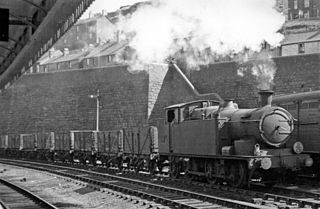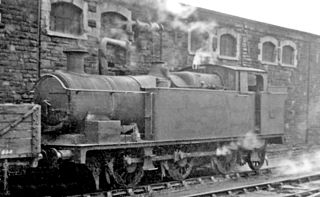
The first Locomotives of the Great Western Railway (GWR) were specified by Isambard Kingdom Brunel but Daniel Gooch was soon appointed as the railway's Locomotive Superintendent. He designed several different 7 ft 1⁄4 in broad gauge types for the growing railway, such as the Firefly and later Iron Duke Class 2-2-2s. In 1864 Gooch was succeeded by Joseph Armstrong who brought his standard gauge experience to the workshops at Swindon. To replace some of the earlier locomotives, he put broad gauge wheels on his standard gauge locomotives and from this time on all locomotives were given numbers, including the broad gauge ones that had previously carried just names.

The Great Western Railway (GWR) 4500 Class or Small Prairie is a class of 2-6-2T steam locomotives.
The GWR was the longest-lived of the pre-nationalisation railway companies in Britain, surviving the 'Grouping' of the railways in 1923 almost unchanged. As a result, the history of its numbering and classification of locomotives is relatively complicated. This page explains the principal systems that were used.

The Burry Port and Gwendraeth Valley Railway (BP&GV) numbers 4 Kidwelly and 5 Cwm Mawr were small 0-6-0ST steam locomotives, originally built by the Avonside Engine Company in May 1903 and April 1905 respectively.
The Lambourn Valley Railway (LVR) was a branch railway line running from the town of Newbury, Berkshire north-west to the village of Lambourn. It was opened in 1898. Fulfilling a local need, it was in financial difficulties throughout its independent life and was sold to the Great Western Railway (GWR) in 1905.

The Rhymney Railway M class was a class of 0-6-2T tank locomotive introduced into traffic on the Rhymney Railway in 1904. These were substantial sized tank engines, and weighed 66 long tons and were 36 feet 9 inches (11.20 m) in length.

The Rhymney Railway A class were 0-6-2T tank locomotives introduced into traffic in 1910 and designed by the railway's engineer Hurry Riches. These were substantial sized tank engines, and weighed 64 long tons and were 35 ft 9 in (10.90 m) in length.

The Rhymney Railway P class was a class of 0-6-2T steam locomotive introduced into traffic in 1909 designed by the Rhymney Railway's engineer C. T. Hurry Riches. These were substantial sized tank locomotives, weighed 60 long tons and were 35 feet 0 inches (10.67 m) in length.

From 1920, the cab side of Great Western Railway (GWR) steam locomotives bore a letter on a coloured disc, which enabled staff to quickly assess the capabilities of locomotives without the need to check tables of data. The letter showed the power classification, and the coloured disc showed the weight restriction. This system continued after the GWR became the Western Region of British Railways.
The GWR 378 Class was a class of 30 standard-gauge 2-2-2 steam locomotives on the Great Western Railway in Britain. They were introduced in 1866, and the class remained intact until 1898. Several were altered to the 0-6-0 wheel arrangement, and the last was withdrawn from service in 1920.

The Cambrian Railways Class 89s were an 0-6-0 tender locomotive introduced by Jones in 1903 for general use over their system, upon grouping they became Great Western Railway class 15 and were reboilered from 1924 onwards with Swindon parts.
Barry Railway Class J were 2-4-2T steam tank locomotives of the Barry Railway in South Wales. They were designed by J. F. Hosgood, built by both Hudswell Clarke and Sharp, Stewart and Company and were introduced in 1897. Their main use was on the Barry to Cardiff suburban service and had a reputation for always being smartly turned out. They were all shedded at Barry. The locomotives passed to the Great Western Railway in 1922. None survived into British Railways ownership and none have been preserved.
Barry Railway Class G were 0-4-4T steam tank locomotives of the Barry Railway in South Wales. They were designed by J. F. Hosgood, built by both Vulcan Foundry and Sharp Stewart and were introduced in 1892. Initially used for the Barry to Cardiff suburban service, they were transferred to passenger duties on the main line between Barry and Porth as well as the service between Pontypridd Graig and Cardiff Clarence Road, once the ‘J’ class had displaced them on the Barry to Cardiff run. The company insisted that their passenger locomotives should be smartly turned out and the ‘G’ class was no exception. The locomotives passed to the Great Western Railway in 1922. None survived into British Railways ownership and none have been preserved.
Barry Railway Class D were 0-8-0 steam tender engines of the Barry Railway in South Wales. They were built to a standard Sharp, Stewart and Company design modified by John Waddington Mann, the Chief Mechanical Engineer for the Swedish & Norwegian Railway. In fact, 20 of these locomotives were ordered by this railway. However the company ran into severe financial difficulty with the result that only one and a half locomotives were paid for by the S&N.
Barry Railway Class F were 0-6-0ST steam saddle tank engines of the Barry Railway in South Wales. They were designed by J. H. Hosgood and built by a number of British companies.
Barry Railway Class E were 0-6-0T steam tank engines of the Barry Railway in South Wales. They were designed by J. H. Hosgood and built by Hudswell Clarke. The locomotive was designed for light shunting duties at the docks. Their small size made them particularly suited to shunting on the Barry Island Breakwater. Access to the breakwater was via a rough hewn tunnel whose dimensions and sharp curves made it impossible for the other locomotives to negotiate a way through.
Barry Railway Class C were originally 2-4-0T steam tank engines of the Barry Railway in South Wales. They were designed by J. H. Hosgood and built by Sharp Stewart.
The Taff Vale Railway H class was a class of 3 0-6-0T steam tank locomotives designed by Tom Hurry Riches, built by Kitson & Co. and introduced to the Taff Vale Railway in 1884. They were primarily used on the Pwllyrhebog Colliery Incline, and had special tapered boilers for this purpose.
Barry Railway Class A were the first steam tank engines to be built for the Barry Railway in South Wales and had a 0-6-0T wheel arrangement. They were designed by John Wolfe Barry and built by Sharp Stewart.

The GWR Rheidol Tanks are a fleet of 2-6-2T steam locomotives of the Great Western Railway design built between 1923 and 1924. They were designed by the railway's Chief Mechanical Engineer, Charles Collett, for working services on the Vale of Rheidol Railway between Aberystwyth and Devil's Bridge.








